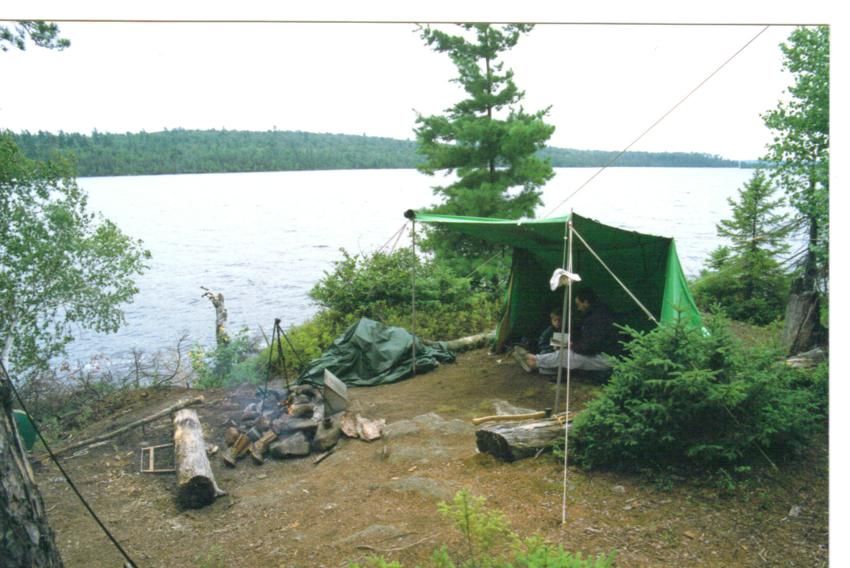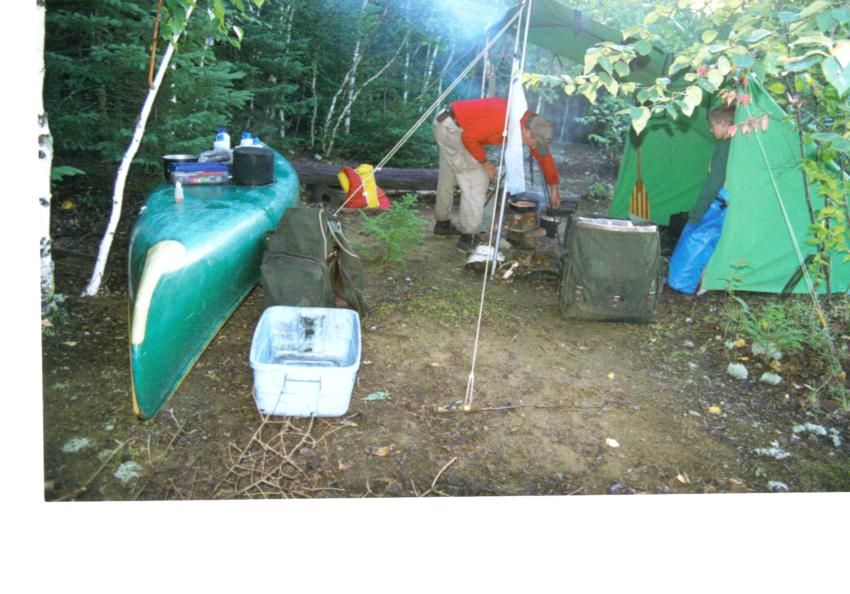Mason / Baker style tents: A dissenting opinion
Mason / Baker style tents: A dissenting opinion
I'm of a very different mind on this one and thought I'd offer a dissenting opinion.
When I was just getting started with canoe-tripping and first read Mason's Song of the Paddle and watched his unforgettable movies, I was very strongly inspired to try such a tent. I was charmed by Mason's descriptions and photos of the pleasures of sitting in one's tent, enjoying a river view, coffee mug in hand, with the fire nearby under the tent's awning. It's very romantic imagery.
However, after years of canoe-tripping and talking at length with people who have used such a tent, I think that, for canoe-tripping purposes, the Mason/Baker style tent is inferior to modern free-standing dome tents for many reasons which I will list below. Unless one is committed to tripping in accordance with a certain aesthetic tradition for it's own sake, there are just too many ways in which Mason/Baker style of shelter is lacking. What follows are why I think so.
-They are needlessly bulky when packed, which means they occupy far more real estate in your pack, which means you need to lug more packs on your portages and they take up precious room in your boat.
-They are almost comically heavy compared to a modern tent, making them a hardship on portages.
-They take longer to setup because one has to cut poles, anchor them more securely against winds. By contrast, one can pitch a modern tent and string a modern lightweight tarp in less time it takes just to find and cut the necessary poles for a Mason/Baker style tent.
- They fare badly in the wind or bad weather because of their shape. Unlike modern tents which are domed to deflect wind and have a low profile and thus hold up well against even violent winds, the Mason/Baker tent is taller and has flat vertical surfaces which catch the wind like a sail and rustle and flap all night. They typically have one angled wall that can deflect some wind, but users have told me that the angled back wall seldom matters, since big winds from rainstorms typically come at you from open areas (namely the water) and so most of the time your tent's opening faces into the wind, rather than the wind glancing off the slanted back wall of the tent.
- They have no floor, which means one has to be more selective about site selection, otherwise, even with a ground cloth, your bedding will get wet from ground runoff. By contrast, I was once forced to pitch my dome tent in the only available flat spot, which happened to be in a depression. Anticipating overnight rains I lined the inside of my tent with a very thin plastic sheet in case a lot of water pooled in the depression where I was pitched. Water did pool beneath my tent and a tiny amount of water did percolate up through the fabric of the bathtub-style floor of my tent, but the plastic sheet protected me and my bedding from all moisture. This would hardly have been possible with a floorless tent, even with a plastic sheet (much less a very thin and light one). The bathtub floors of modern tents are a real plus when one is forced to pitch in an undesirable location.
- They have a larger footprint, especially when one take into consideration the awning area in front. This too limits where one can pitch such a tent.
- They take longer to dry out, longer to strike, and are harder to pack up. A modern dome tent's synthetic fabric airs out and dries out faster, can be struck very fast and crammed into it's stuff sack much faster, all of which matters on days where one wants to break camp quickly for an early start.
- They are much too heavy for backpacking trips, which means - if you're a backpacker too - you need to own two tents instead of just one.
Mason's primary objection to modern tents was that they are a "doghouse" because they're small and low. He was right. They are. But that's actually a virtue, provided one doesn't try to live in it. I don't live in my tent. I just sleep in it. I'll occasionally nap in it, and when I do, I never have to worry about the wind blowing the campfire smoke into my shelter. I do my living, my relaxing, cooking, eating, camp crafts, and socializing 'round the fire, under my tarp...which provides me cover from rain, wind, and sun and can be strung where I can enjoy the best view or catch the best breeze. My doghouse is light, compact, dries out fast, takes 2 minutes to pitch or strike (no exaggeration there), holds up better in wind and rain, keeps out the bugs, mice, and ground water, and it needn't be pitched where there's a view or where I will make my fire, but rather in the flattest and most level spot I can find.
So, while I do share in that romantic nostalgia for older-style tents, I find them too impractical and frankly inadequate compared to modern self-standing dome tents.
Hope this helps,
- Martin













